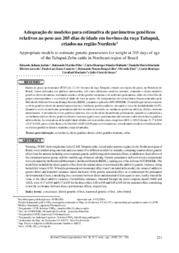Adequação de modelos para estimativa de parâmetros genéticos relativos ao peso aos 205 dias de idade em bovinos da raça Tabapuã, criados na região Nordeste.
Adequação de modelos para estimativa de parâmetros genéticos relativos ao peso aos 205 dias de idade em bovinos da raça Tabapuã, criados na região Nordeste.
Author(s): JACINTO, E. J.; MARTINS FILHO, R.; MALHADO, C. H. M.; AZEVEDO, D. M. M. R.; CARNEIRO, P. L. S.; LOBO, R. N. B.; FACO, O.; MACHADO, C. H. C.; SOUZA, J. C. de
Summary: Resumo: Dados de pesos ao desmame (P205) de 12.181 bovinos da raça Tabapuã, criados em regime de pasto, no Nordeste do Brasil, foram utilizados em análises univariadas, sob cinco diferentes modelos animais, contendo o efeito aleatório genético direto do animal, incluindo ou não o efeito genético materno e de ambiente permanente, além do efeito fixo de grupo contemporâneo e a covariável idade da vaca ao parto. Os componentes de (co)variância foram estimados pelo Método da Máxima Verossimilhança Restrita (REML), usando o aplicativo MTDFREML. O modelo que incluiu somente o efeito genético direto do animal superestimou a variância genética aditiva, elevando o valor da herdabilidade (0,39). Quando o efeito de ambiente permanente não foi incluído no modelo, as variâncias genéticas aditivas, direta e materna aumentaram. A inclusão do efeito genético materno, em vez do efeito de ambiente permanente, quando se considerou a covariância entre os efeitos genéticos direto e materno igual a zero, praticamente não alterou o valor da variância genética aditiva direta. As estimativas de herdabilidade obtidas sob os modelos mais completos (MA1 e MA2) foram: 0,17 ± 0,04 e 0,17 ± 0,03, para o efeito direto, e 0,10 ± 0,04 e 0,09 ± 0,03 para o efeito materno, considerando ou não a covariância entre os efeitos genéticos direto e materno, respectivamente. Appropriate models to estimate genetic parameters for weight at 205 days of age of the Tabapuã Zebu cattle in Northeast region of Brazil. Abstract: Weaning (W205) bodyweight data from 12.181 Tabapuã cattle, raised under pastures regime in the Northeast region of Brazil, were studied using one-trait analyses under five different models for animals, containing random direct genetic effect from the animal, including or not maternal genetic and lifelong environmental effects, in addition to fixed effects of the contemporaneous group, and the variable age of dam at calving. Genetic parameters and (co)variance components were estimated by the Restricted Maximum Likelihood Method (REML), making use of the software MTDFREML. The model that included the direct genetic effect from the animal alone overestimated the addictive genetic variance, rising heritability values (0.39). When the permanent environmental effect wasn?t included in the model, the values of addictive genetic direct and maternal variances raised. Inclusion of the genetic maternal effect, as a replacement for permanent environmental effects, considering the covariance between direct and maternal effects equal to zero, hardly altered the value of the direct additive variance. Heritabilities estimates, obtained through the most complete model (AM1 and AM2), were: 0.17 ± 0.04 and 0.17 ± 0.03 for the direct effect, 0.10 ± 0.04 and 0
Publication year: 2005
Types of publication: Journal article
Unit: Embrapa Goats & Sheep
Observation
Some of Embrapa's publications are published as ePub files. To read them, use or download one of the following free software options to your computer or mobile device. Android: Google Play Books; IOS: iBooks; Windows and Linux: Calibre.
Access other publications
Access the Agricultural Research Database (BDPA) to consult Embrapa's full library collection and records.
Visit Embrapa Bookstore to purchase books and other publications sold by Embrapa.

